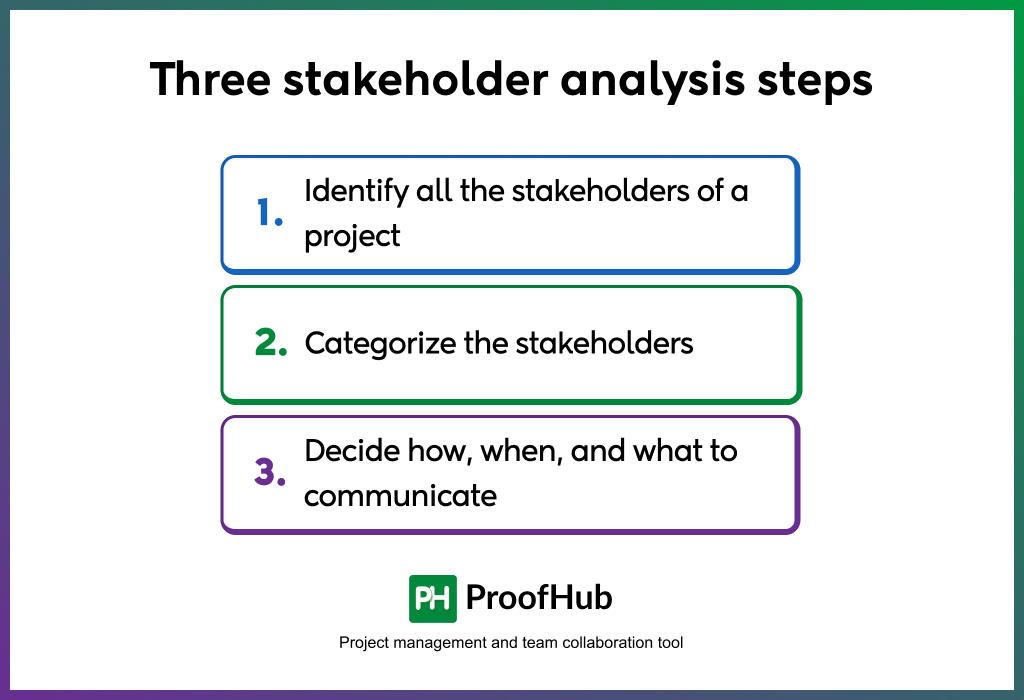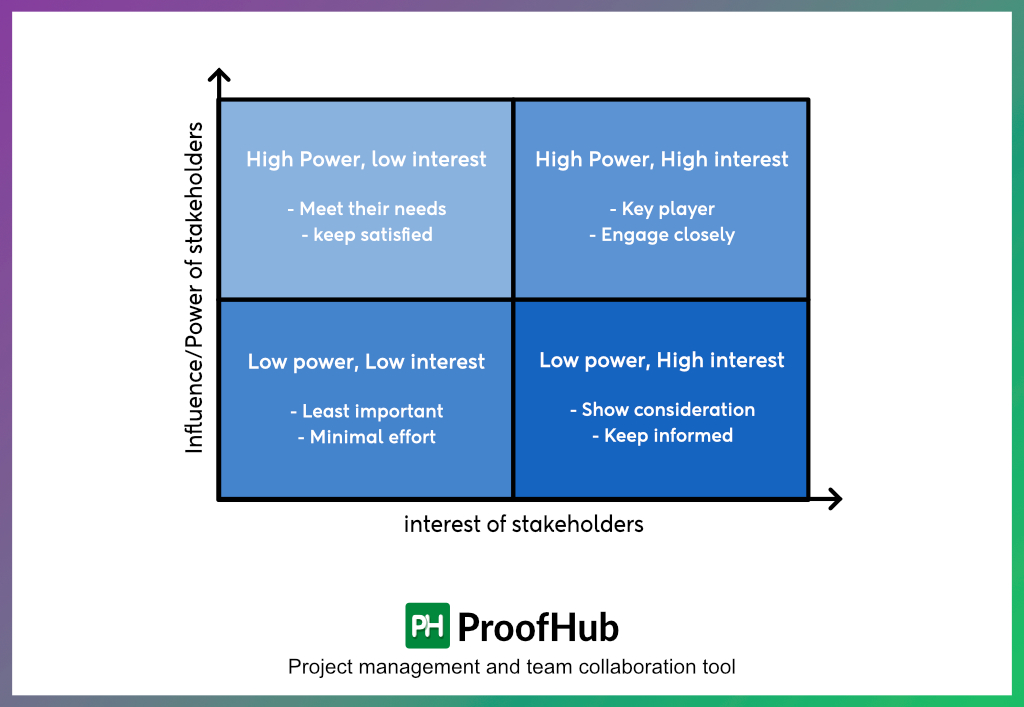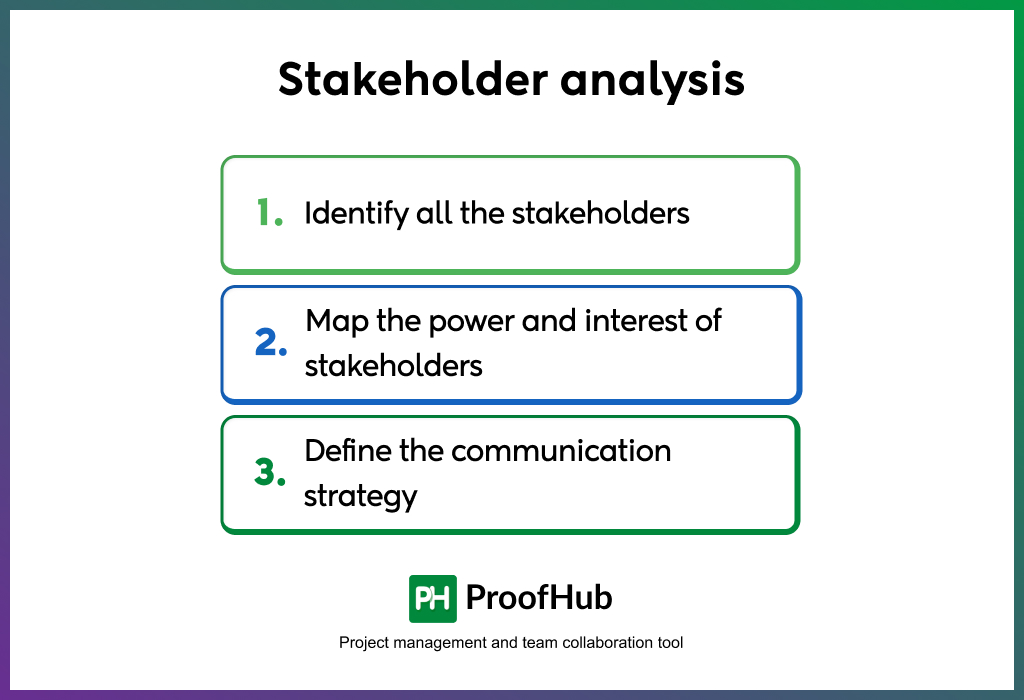Stakeholder analysis is a crucial process in a project. It helps identify, categorize, and engage stakeholders effectively. It involves understanding different types of stakeholders, assessing their influence and interests, and leveraging tools and techniques to manage them efficiently.
By conducting a thorough stakeholder analysis, you can improve communication, minimize risks, and enhance project success.
In this article, we will explore the definition, types, benefits, key steps, and essential tools used in stakeholder analysis.
What is a stakeholder?
A stakeholder is any individual, group, or organization interested in or affected by a project, business, or decision. Stakeholders can include employees, customers, investors, suppliers, governments, and communities with varying levels of involvement.
What is stakeholder analysis?
Stakeholder analysis is the process of identifying and evaluating stakeholders based on their interest and role in a project or business. It helps you understand stakeholders’ needs, expectations, and potential impact on a project.
What is the main purpose of stakeholder analysis?
Stakeholder analysis is the process of identifying all the stakeholders of a project, their needs, influences on the project, and communication requirements.
The main purpose of stakeholder analysis is to assess the influence, impact, and relationships of stakeholders to manage their involvement effectively. By recognizing stakeholders’ perspectives and concerns, organizations can make informed decisions, build positive relationships, and navigate potential challenges more successfully throughout a project.
What are the types of stakeholders?
Stakeholder categorization can be done in 3 ways in two types; it can vary depending on the project:
Internal vs External Stakeholders
- Internal Stakeholders – Internal stakeholders are the people within the organization. They can include employees, investors, project managers, a company owner, the board of directors, executive leaders, and more.
- External Stakeholders – External stakeholders are the people outside the organization. They include customers, business vendors, community, government, contractors, suppliers, and more.
Primary vs Secondary Stakeholders
- Primary Stakeholders – Primary stakeholders are the people directly impacted by a project or business decision. They can include employees, customers, investors, and business owners directly interested in the outcomes.
- Secondary Stakeholders – Secondary stakeholders are indirectly affected by a project or business decision. They include media, government agencies, advocacy groups, and the general public who may be interested but are not directly involved.
Direct vs Indirect Stakeholders
- Direct Stakeholders – Direct stakeholders are actively involved in the project or business operations. They can include employees, project teams, investors, and customers who engage with the organization’s activities.
- Indirect Stakeholders – Indirect stakeholders are those interested in the project or business but are not directly involved. They include regulators, environmental groups, community organizations, and the general public who may be affected by the outcomes.
What are the benefits of stakeholder analysis?
Stakeholder analysis helps you gain more information and insights from everyone involved in a project to ensure success. This analysis enables better communication, risk management, and engagement strategies for project success.
The five main benefits of stakeholder analysis are:
- Identifies key stakeholders and their interests – Helps you recognize who can impact or be impacted by a project, ensuring their roles are defined and needs are considered.
- Enhances communication and collaboration – Encourages transparent discussions, improves stakeholder collaboration at all levels, which aligns stakeholders with project goals.
- Reduces risks and potential conflicts – Identifying stakeholder concerns early helps mitigate issues before they become major.
- Supports better decision-making and planning – Understanding stakeholder priorities adds different perspectives to project planning, allowing for more informed and strategic decision-making.
- Increases project success rates and efficiency – Clearly addressing stakeholder roles and needs ensures smoother project execution and goal achievement.
Stakeholder analysis in project management
In project management, stakeholder analysis helps you gain an in-depth understanding of all the stakeholders in a project, ensure an early alignment among all stakeholders on project goals and plans, and address conflicts among them early on. It increases the chances of achieving the goals of all the stakeholders in a project.
If a project does not meet the expectations of all the stakeholders, it cannot be called a successful project. Let’s understand it with an example.
You can create an exceptional product for your company, but you overrun the budget and time. This may be a successful project for the employees and customers, but it may not be for the investors as it significantly reduces profit margins. Thus, despite the success of the project in the market, it is not a successful project for all stakeholders.
Stakeholder analysis in project management helps you ensure the interests of all the stakeholders in a project are met.
3 Steps to conduct a stakeholder analysis?
Conducting a stakeholder analysis is a three-step process: identifying all the stakeholders of a project, categorizing the stakeholders, and deciding how, when, and what to communicate.

Here is the explanation of the three stakeholder analysis steps:
1. Identify all the stakeholders of a project
Think of all the interested parties in a project. The simple way to do that is to ask yourself a question: who are the people who can influence the project or be influenced by the project?
Start writing down the names of all the interested parties in a project. The list can somewhat look like this:
- C-level executives such as the CEO, owner, and members of the board of directors
- Investors and sponsors
- Employees
- Customers
- Program and project managers
- Suppliers and vendors
- Government agencies
2. Categorize the stakeholders
We all know that not all stakeholders have equal influence, power, and interest in the project. Thus, you need to categorize all the stakeholders based on their influence and interests.
The most popular framework for doing so is a power-interest grid. It groups all the stakeholders into four quadrants based on power and interest, and this stakeholder analysis map suggests the course of action in communication for stakeholders in each group.

The X-axis represents interest, and the Y-axis represents power.
The power interest grid groups stakeholders into four categories.
- High power, high interest (manage closely): These are the most important stakeholders of your project, and you want to keep them most interested in your project. You need to keep them at the top of the priority list of stakeholders.
Priority: High
- High power, low interest (keep satisfied): These are the people you need to keep satisfied because of their influence in the project. But as they have low interest, you do not want to turn them off with over-communication.
Priority: High
- Low power, high interest (keep informed): These are the people who play a key part in the success of the project. You need to keep them informed regularly to ensure the successful execution of the project.
Priority: Medium
- Low power, low interest (monitor): These are the least important stakeholders of your project, and they are not going to add a ton of value based on their influence. You just need to monitor these stakeholders and inform them periodically about the progress.
Priority: Low
3. Decide how, when, and what to communicate
Now, you have grouped all the stakeholders in these four quadrants. It is time to decide how, when, and what to communicate. You need to:
- Decide the communication frequency
- Decide the communication method
- Define the information you need to share and the buy-in you want from each stakeholder in the decision-making process.
To do so, you need some brainwork. The ideal process would be to interview each stakeholder and find out what they expect and what you can expect from them.
Here are a few questions that help you start with the process:
- What is their definition of success in the project?
- What financial and emotional interests do they have in this project?
- How do they want to contribute to the project?
- How do they want to be communicated?
- What are their views on the project?
- What impact does project outcome have on them
- Who influences their opinions generally?
- What is their view of the project, and will this stakeholder likely have a positive impact on the project?
- What are the possible points of conflict with other stakeholders that they might have
Doing so, at the beginning, helps you reduce the project risks, plan the projects better, and keep everyone in alignment.
Example of stakeholder analysis
Let’s understand the importance of stakeholder analysis with a practical example. Suppose you are developing an e-commerce app for a client.
Here’s an example of stakeholder analysis:

1. Identify all the stakeholders
Key stakeholders of a project are:
- Client (it can include multiple stakeholders such as owner, chief technical officer, marketing team, and legal team)
- Product owner
- Project manager
- Development and design team
- Customers (end-users)
- Business development team
Other stakeholders of a project are:
- Regulatory authorities
- Executive leadership
2. Map the power and interest of stakeholders
| Influence | Interest | |
|---|---|---|
| Client | High | High |
| Product owner | High | High |
| Development and design team | Medium | High |
| End-users | Low | High |
| Business development team | Low | Medium |
| Regulatory authorities | Low | Low |
| Executive leadership | High | Low |
3. Define the communication strategy
Here, the most important stakeholder in this e-commerce project is the client. The role of a project manager is to ensure all the goals of the project are achieved. Thus, the client needs to keep engaged at every step of the project.
For example, if you receive feedback from the end user about a feature, you need the client’s approval before starting work on it. During the stakeholder analysis, you need to clearly define where you need the client’s buy-in and attention, when to communicate, and how to communicate.
Here is the communication template:
- Stakeholder name: Nick
- Title: Client
- Communication frequency: Weekly
- Decision maker: Yes
- Mode of communication: Video conference/phone
- Influence: High
Similarly, you need to define for every stakeholder how much buy-in you want from each in the decision-making process, to whom you should inform about the changes, and who the stakeholders are who are least interested in the project.
Stakeholder analysis tools
You can perform a stakeholder analysis using a pen and paper. In the past, project managers did that as there were no tools. Then, as soon as Excel spreadsheets were available, they started using it for performing comprehensive stakeholder analysis, documenting it, and making it easy to share.
Currently, we have project management tools that can help you with multiple features like templates, graphs, and maps to help you with stakeholder analysis.
Here are the three stakeholder analysis tools you have:
1. Standard methods
Various methods can help you get started with stakeholder analysis. Stakeholder mapping, power-interest grid matrix, and RACI matrix are some of the most popular stakeholder analysis techniques.
- Stakeholder map: A stakeholder map is the visual representation of relationships among various stakeholders involved in a project. It visualizes how stakeholders are interconnected and their stakes in the project.
- Power-interest grid matrix: The power-interest grid matrix is another technique to define the influence and interest of each stakeholder in a project.
- RACI matrix: The RACI matrix is another powerful method to define who is responsible, accountable, consulted, and informed for every action in the project.
- Stakeholder analysis matrix: The stakeholder analysis matrix is a powerful technique that includes the key information of a stakeholder, such as name, power, interest levels, point of contact, priorities, project impact, communication frequency, and engagement strategy.
- Interviewing stakeholders: Direct interviewing stakeholders is the best way to gather information about what they expect and how they will be involved.
2. Templates
There are templates for every stakeholder analysis method mentioned above that guide on how to do a stakeholder analysis. You can use the templates to conduct a stakeholder analysis. You can also simply create your templates using Excel spreadsheets to perform stakeholder analysis.
3. Stakeholder management software
Stakeholder management software provides the tools you need for complete stakeholder management, not just stakeholder analysis. You get pre-built templates, tools to create maps, graphs, and tables, documentation tools, and collaboration features to perform an in-depth stakeholder analysis.
Apart from that, you get the tools you need for stakeholder management, such as Gantt charts, product roadmaps, and reports to review the progress.
The purpose of using stakeholder management software is to make life easy for the project manager, document every step of the process, and create a centralized place for all the information related to stakeholders.
If you are looking for a powerful system for stakeholder analysis and management to make your projects successful, ProofHub is a great choice of tools to bring your project, stakeholders, and teamwork to one place.
ProofHub provides you with a set of tools for effective stakeholder management:
- Gantt chart: If a key stakeholder wants to visualize the product journey, you have the Gantt chart to visualize the project roadmap, key milestones, and other key details of the project.
- Project discussions: If a stakeholder wants to share some insights, discussions at the project level help them share the information with the team.
- Reports: If a stakeholder wants to check the project’s progress, they can refer to the project reports to get an overview and gain an understanding.
- Task management: You have a centralized task management system for internal stakeholders to stay on top of the project management.
- Advanced collaboration features: Features like custom roles, forms, online proofing, notes, and file import and export make it easy to collaborate with external stakeholders.
You can try ProofHub free for 14 days. Sign up by clicking here
Frequently asked questions
1. What is the first step in a stakeholder analysis?
The first step in a stakeholder analysis is to identify all the stakeholders of a project. You need to name all the people who can influence the project or can be influenced by the project. Common stakeholders of a project include the product owner, C-level executives, the project manager, the engineering/development team, customers (end-users), vendors and suppliers, government agencies, and regulating authorities.
2. What are the key objectives of stakeholder analysis?
The key objectives of stakeholder analysis are to identify all the stakeholders, their needs, and their influences on the project. It is the role of a project manager to ensure the goals of all the stakeholders in a project are fulfilled.
3. What are some common challenges in stakeholder analysis?
The most common challenges in stakeholder analysis are a breakdown in communication, lack of resources, and absence of formal and standardized processes for stakeholder analysis.
4. What is the purpose of a stakeholder analysis?
The purpose of all the stakeholder analysis is to identify all the stakeholders in a project, understand their influences, roles, and expectations, and create a plan to manage all the stakeholders in a project based on the gained understanding.

